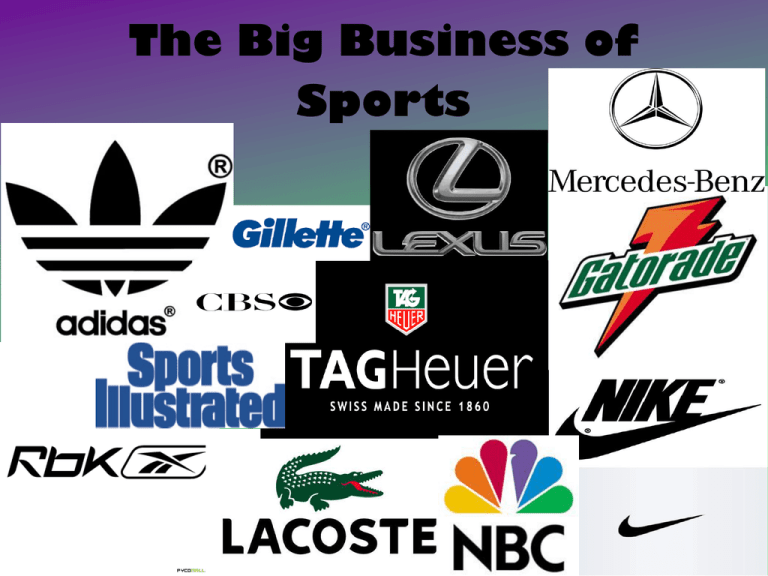The Big Business of Sports
advertisement

The Big Business of Sports The Business of Sport Entertainment Amateur athletes: derive no financial or material rewards from the sporting efforts Compete in the Olympics Professional athletes: make a living playing sports (contracts) Other forms of profit: endorsement deals and the sale of merchandise and tickets Money money money money....money In the 1960s and 1970s many elite professional athletes in sports such as hockey, baseball, and basketball typically were paid so little that many needed to work at another job during the offseason Now average salaries (in U.S. Dollars) NBA: $4.0 million MLB: $2.3 million NHL: $1.6 million NFL: $ 1.2 million Winning is Everything In the business sense, winning is everything Reinforces fan loyalty Greater attendance at games More sales of products featuring the team's logo Can charge higher fees for widely watched television broadcasts of games Steady supply of young athletes who want to play for the team Increased revenue can lead to teams having more money available to sign high profile players The Role of the Media Television, radio, internet, newspapers, magazines, and all forms of advertising In the “old days” if you weren't at the game you had to wait until the newspaper came out the next day with the results In the 1930s radio sports broadcasts began allowing live coverage of games Increased the traditional audience size The Influence of Television Similar to radio, provided play-by-play commentary Even wider audience – people could watch games for free from their home Viewers were subjected to interspersed advertisements during commercials Advertisers of every kind of product have lined up to sell their wares to spectators of both live and televised sports Superbowl Advertisements 30 seconds of advertising time during the 2010 telecast is expected to cost US $3 million http://www.youtube.com/watch?v=CFsKeDAJPak&NR =1 http://www.youtube.com/watch?v=S382RoO6s8A http://www.youtube.com/watch?v=79tMMFja-Fw Endorsements Athletes often promote products that are unrelated to their field of work i.e. Tiger Woods for Buick “lifestyle marketing” Companies assume that sports fans will transfer the admiration they have for these athletes into a desire to purchase things their heros endorse http://www.youtube.com/watch?v=IpfzaqIuR34 The Nike Story The company started in 1964 - “Nike” is the name of the goddess of victory in Greek Mythology Started with running shoes Now manufacture shoes and apparel for every sport imaginable Endorse high profile athletes like Tiger Woods, Kobe Bryant, Rafael Nadal, Michael Jordan Just Do It.... These athletes endorse the company's products in all forms of media – commercials, print ads in magazines, giant billboards, etc. Paid Tiger Woods US $40 million Spent $100 million on advertising at the 1996 Olympics in Atlanta, even though it was not an official sponsor However... Nike has come under scrutiny for its labour practices Part of their success is due to the fact that the manufacturing of their products takes place in low-wage Third World countries (saves them $) Sweatshop – unsafe working condition and low wages Athletes like Woods and Jordan are reluctant to comment on their labour practices Nike Commercials http://www.youtube.com/watch?v=rHHMaiNyztk http://www.youtube.com/watch?v=mSzGpC5Xih c&NR=1 http://www.youtube.com/watch?v=4ltPJvKo7Yk &feature=related And the best for last: http://www.youtube.com/watch?v=3O85VVZaB Ho











